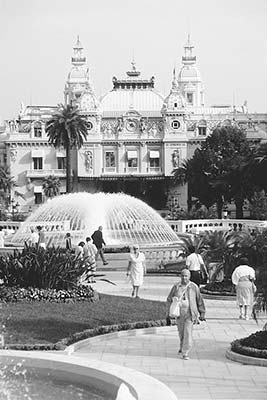
Despite high prices, wall-to-wall daytime tourists, and a Disney-esque atmosphere, Monaco is a Riviera must. Monaco is on the go. Since 1929, cars have raced around the port and in front of the casino in one of the world’s most famous auto races, the Grand Prix de Monaco. The modern breakwater—constructed elsewhere and towed in by sea—enables big cruise ships to dock here, and the district of Fontvieille, reclaimed from the sea, bristles with luxury high-rise condos. But don’t look for anything too deep in this glittering tax haven. Many of its 36,000 residents live here because there’s no income tax—there are only about 6,000 true Monegasques.
This minuscule principality (0.75 square mile) borders only France and the Mediterranean. The country has always been tiny, but it used to be...less tiny. In an 1860 plebiscite, Monaco lost two-thirds of its territory when the region of Menton voted to join France. To compensate, France suggested that Monaco build a fancy casino and promised to connect it to the world with a road (the Low Corniche) and a train line. This started a high-class tourist boom that has yet to let up.
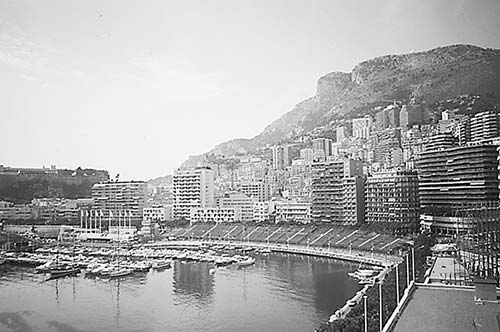
Although “independent,” Monaco is run as a part of France. A French civil servant appointed by the French president—with the blessing of Monaco’s prince—serves as state minister and manages the place. Monaco’s phone system, electricity, water, and so on, are all French.
The glamorous romance and marriage of the American actress Grace Kelly to Prince Rainier added to Monaco’s fairy-tale mystique. Princess Grace first came to Monaco to star in the 1955 Alfred Hitchcock movie To Catch a Thief, in which she was filmed racing along the Corniches. She married the prince in 1956 and adopted the country, but tragically, the much-loved princess died in 1982 after suffering a stroke while driving on one of those same scenic roads. She was just 52 years old.
The death of Prince Rainier in 2005 ended his 56-year-long enlightened reign. Today, Monaco is ruled by Prince Albert Alexandre Louis Pierre, Marquis of Baux—son of Prince Rainier and Princess Grace. Prince Albert was long considered Europe’s most eligible bachelor—until he finally married on July 2, 2011, at age 53. His bride, known as Princess Charlene, is a South African commoner 20 years his junior.
A graduate of Amherst College, Albert is a bobsled enthusiast who raced in several Olympics, and an avid environmentalist who seems determined to clean up Monaco’s tarnished tax-haven, money-laundering image. (Monaco is infamously known as a “sunny place for shady people.”) Monaco is big business, and Prince Albert is its CEO. Its famous casino contributes only 5 percent of the state’s revenue, whereas its many banks—which offer a hard-to-resist way to hide your money—are hugely profitable. The prince also makes money for Monaco with a value-added tax (20 percent, same as in France), plus real estate and corporate taxes.
Monaco is a special place: There are more people in Monaco’s philharmonic orchestra (about 100) than in its army (about 80). Yet the princedom is well guarded, with police and cameras on every corner. (They say you could win a million dollars at the casino and walk to the train station in the wee hours without a worry.) Stamps are printed in small quantities and increase in value almost as soon as they’re available. And collectors snapped up the rare Monaco versions of euro coins (with Prince Rainier’s portrait) so quickly that many Monegasques have never even seen one.
The principality of Monaco has three tourist areas: Monaco-Ville, Monte Carlo, and La Condamine. Monaco-Ville fills the rock high above everything else and is referred to by locals as Le Rocher (“The Rock”). This is the oldest part of Monaco, home to the Prince’s Palace and all the key sights except the casino. Monte Carlo is the area around the casino. La Condamine is the port, which lies between Monaco-Ville and Monte Carlo. From here it’s a 20-minute walk up to the Prince’s Palace or to the casino, or a few minutes by frequent bus to either (see “Getting Around Monaco,” later).
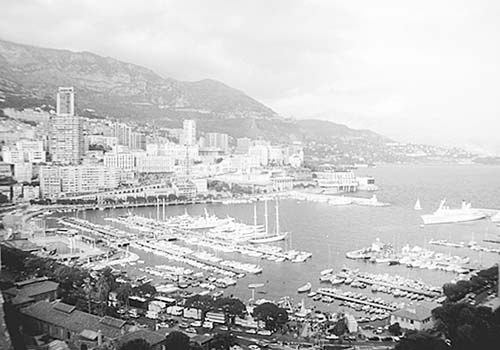
Most travelers will want to organize their trip around the 11:55 Changing of the Guard at the palace and touring the casino. The surgical-strike plan is to start at Monaco-Ville (where you’ll spend the most time and see the Changing of the Guard), wander down along the port area, and finish by gambling away whatever you have left in Monte Carlo (the casino’s high-roller game rooms don’t open until 14:00, but the rest of the joint opens at 9:00). If you don’t care to gamble and can get started early, consider reversing this route: Tour the casino first, then visit Monaco-Ville in time to see the Changing of the Guard. You can walk the entire route in about 1.5 hours, or take three bus trips and do it in 15 minutes.
The main TI is at the top of the park above the casino (Mon-Sat 9:00-19:00, Sun 11:00-13:00, 2 Boulevard des Moulins, tel. 00-377/92 16 61 16 or 00-377/92 16 61 66, www.visitmonaco.com). Another TI is at the train station (daily mid-June-mid-Sept 9:00-18:00, off-season Tue-Sat until 17:00, closed 12:30-14:00, closed Sun-Mon).
By Bus #100 from Nice and Villefranche-sur-Mer: See my “Quickie Riviera Bus Tour” on 392 to plan your route. Bus riders need to pay attention to the monitor showing the next stop. Cap d’Ail is the town before Monaco, so be on the lookout after that (the last stop before Monaco is called “Cimetière”). You’ll enter Monaco through the modern cityscape of high-rises in the Fontvieille district. When you see the rocky outcrop of old Monaco, be ready to get off.
There are three stops in Monaco. In order from Nice, they are Place d’Armes (at the base of Monaco-Ville), Princesse Antoinette (on the port), and Monte Carlo-Casino (in front of the TI on Boulevard des Moulins).
Most riders will get off at Place d’Armes to visit Monaco-Ville first. Use the crosswalk in front of the tunnel, then keep right and find bus stops #1 and #2 and the ramp to the palace. Casino-first types wait for the Monte Carlo-Casino stop. There’s no reason to exit at the port stop.
By Train from Nice: The long, entirely underground train station is in the center of Monaco. From here, it’s a 15-minute walk to the casino or the port, and about 15 minutes to the base of the palace (and frequent local buses). The station has no baggage storage.
The TI, train-ticket windows, and WCs are up the escalator at the Italy end of the station. There are three exits from the train platform level (one at each end and one in the middle).
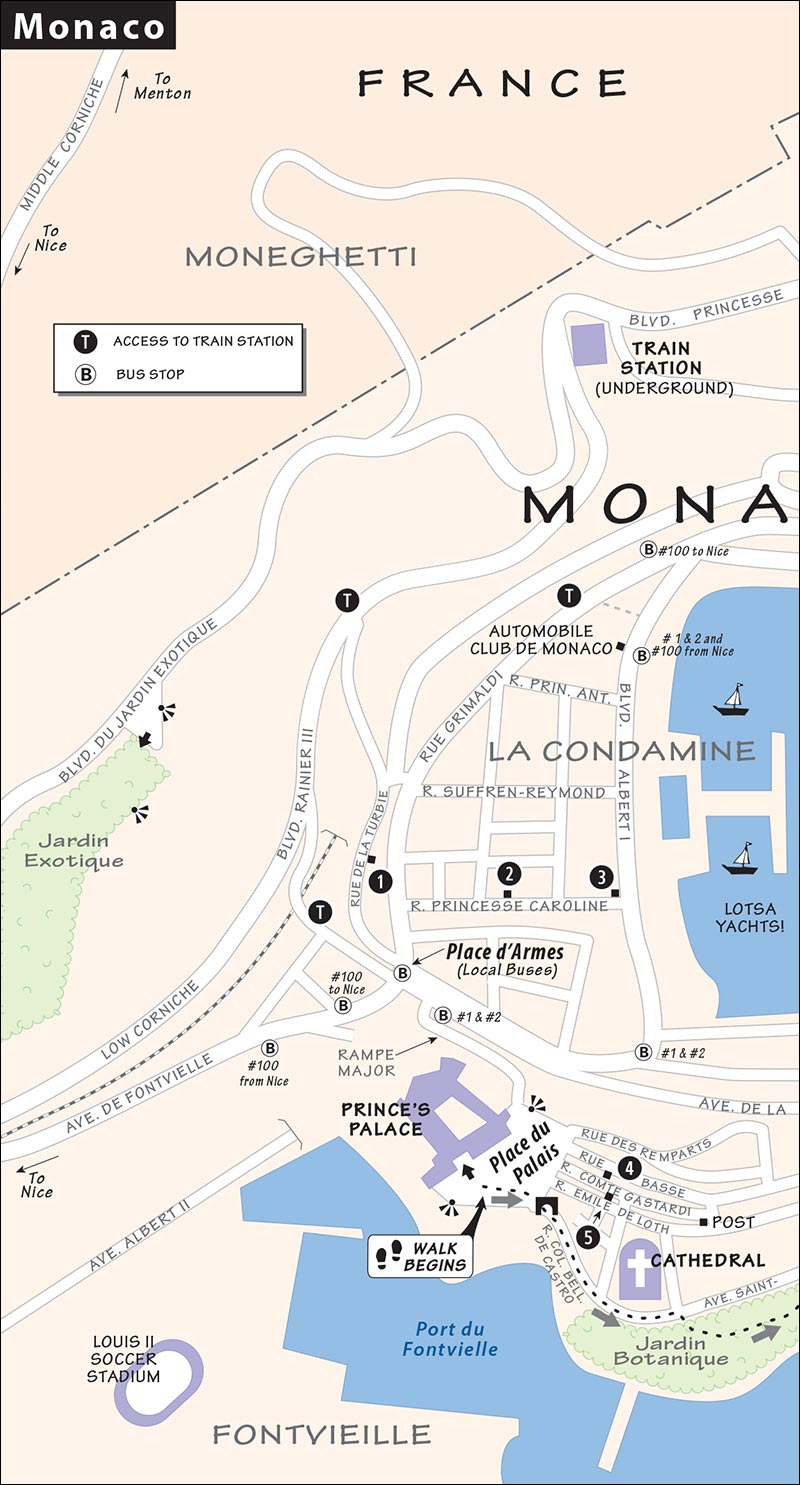
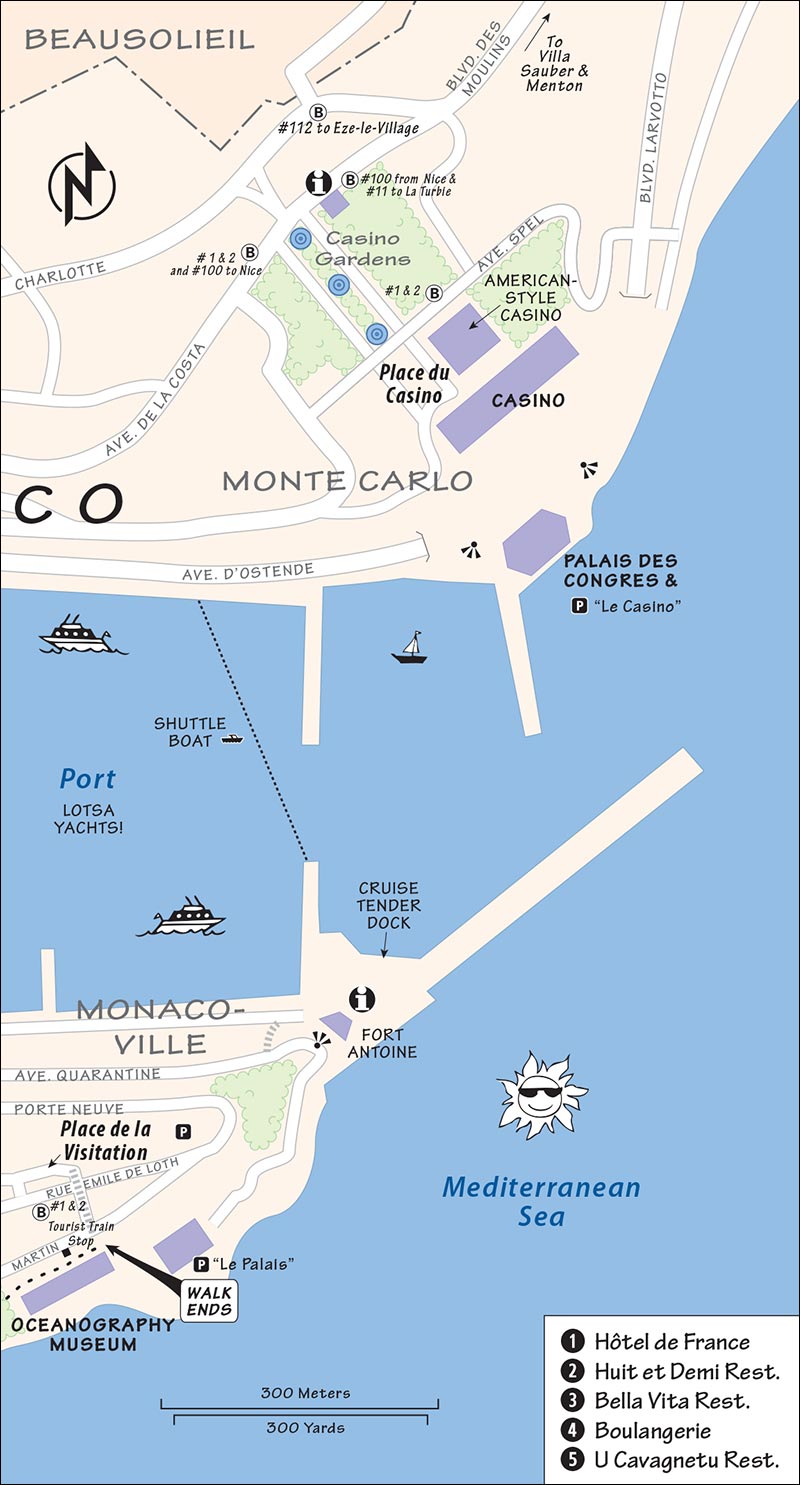
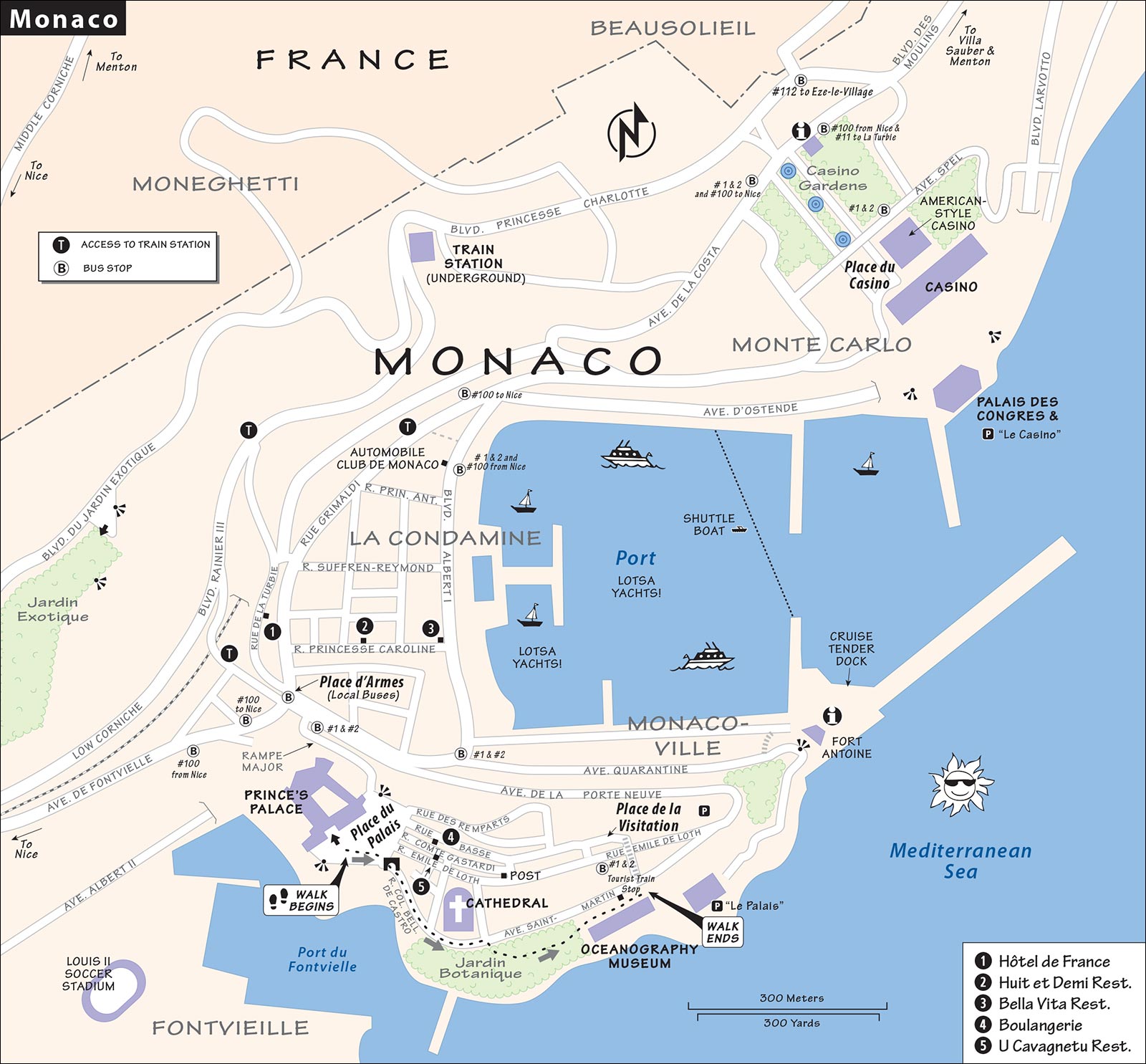
To reach Monaco-Ville and the palace, take the exit at the Nice end of the tracks (signed Sortie Fontvieille/Le Rocher), which leads through a long tunnel and along a pedestrian plaza to the base of Monaco-Ville at Place d’Armes (turn left when you reach the busy street). From here, it’s about a 15-minute hike up to the palace, or five minutes by bus (#1 or #2) plus a short walk.
To reach Monaco’s port and the casino, take the middle exit, following Sortie Port Hercule signs down the steps and escalators, and then Accès Port signs until you pop out at the port, where you’ll see the stop for buses #1 and #2 across the busy street. From here, it’s a 20-minute walk to the casino (up Avenue d’Ostende to your left), or a short trip via bus #1 or #2.
If you plan to return to Nice by train in the evening (after ticket windows close), buy your return tickets on arrival or use the ticket machines (about €4 in coins or use a credit card with a chip).
By Car: Follow Centre-Ville signs into Monaco (warning: traffic can be heavy), then watch for the signs to parking garages at Le Casino (for Monte Carlo) or Le Palais (for Monaco-Ville). You’ll pay about €12 for four hours.
By Cruise Ship: See “Monaco Connections,” near the end of this chapter.
Grand Prix Prep: If you come anytime from early April through May, you’ll encounter construction detours as the country prepares for its largest event of the year, the Grand Prix de Monaco.
Combo-Tickets: If you plan to see both of Monaco’s big sights (Prince’s Palace and Oceanography Museum), buy the €20.50 combo-ticket. Another combo-ticket includes the Prince’s private car collection in Fontvieille (not covered in this book).
Changing of the Guard: This popular event takes place daily (in good weather) at 11:55 at the Prince’s Palace. Arrive by 11:30 to get a good viewing spot.
Loop Trip by Bus or Train: From Nice, you can get to Monaco by bus or train, then take a bus from Monaco to Eze-le-Village or La Turbie, and return to Nice from there by bus. For bus numbers, frequencies, and stop locations, see “Monaco Connections,” near the end of this chapter.
Evening Events: Monaco’s cultural highlights include its Philharmonic Orchestra (tel. 00-377/98 06 28 28, www.opmc.mc) and Monte Carlo Ballet (tel. 00-377/99 99 30 00, www.balletsdemontecarlo.com).
Passport Stamp: For an official memento of your visit, get your passport stamped at the TI.
Post Office: The handiest post office for local stamps is in Monaco-Ville (described on my self-guided walk; Mon-Fri 8:00-19:00, Sat until 13:00, closed Sun).
By Local Bus: Buses #1 and #2 link all areas with frequent service (10/hour, fewer on Sun, buses run until 21:00). If you pay the driver, a single ticket is €2, 6 tickets-€11, a day pass-€5.50; save by using red curbside machines, where you get 12 tickets for €11. You can split a 6-or 12-ride ticket with your travel partners. Bus tickets are good for a free transfer if used within 30 minutes.
For a cheap and scenic loop ride through Monaco, ride bus #2 from one end to the other and back (25 minutes each way). You’ll need two tickets and must get off the bus at the last stop and then get on again.
By Open Bus Tour: You could pay €23 for a hop-on, hop-off open-deck bus tour that makes 12 stops in Monaco, but I wouldn’t. If you want a scenic tour of the principality that includes its best views, take local bus #2 for much less (see above).
By Tourist Train: An efficient way to enjoy a scenic blitz tour, Monaco Tours tourist trains begin at the Oceanography Museum and pass by the port, casino, and palace (€10, 2/hour, 30 minutes, recorded English commentary).
By Taxi: If you’ve lost all track of time at the casino, you can call the 24-hour taxi service (tel. 00-377/93 15 01 01)...assuming you still have enough money to pay for the cab home.
(See “Monaco” map.)
All of Monaco’s major sights (except the casino) are in Monaco-Ville, packed within a few Disneyesque blocks. This self-guided walk connects these sights in a tight little loop, starting from the palace square.
• To get from anywhere in Monaco to the palace square (Monaco-Ville’s sightseeing center and home of the palace), take bus #1 or #2 to the end of the line at Place de la Visitation. Turn right as you step off the bus and walk five minutes down Rue Emile de Loth. You’ll pass the post office, a worthwhile stop for its collection of valuable Monegasque stamps (we’ll go there later—to visit it now, see the end of this walk).
This square is the best place to get oriented to Monaco. Facing the palace, walk to the right and look out over the city (er...principality). This rock gave birth to the little pastel Hong Kong look-alike in 1215, and it’s managed to remain an independent country for most of its 800 years. Looking beyond the glitzy port, notice the faded green dome roof: It belongs to the casino that put Monaco on the map in the 1800s. The casino was located away from Monaco-Ville because Prince Charles III (r. 1856-1889) wanted to shield his people from low-life gamblers.
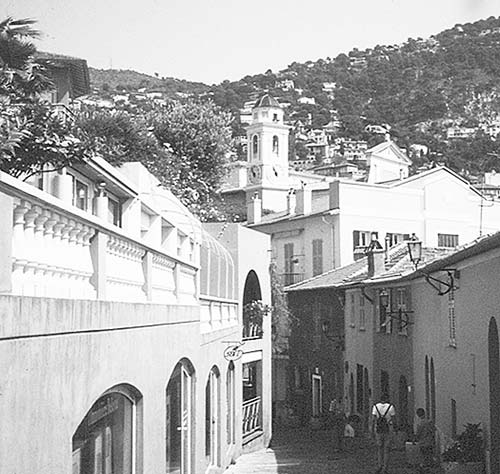
The modern buildings just past the casino mark the eastern limit of Monaco. The famous Grand Prix runs along the port and then up the ramp to the casino (at top speeds of 180 mph). Italy is so close, you can almost smell the pesto. Just beyond the casino is France again (it flanks Monaco on both sides)—you could walk one-way from France to France, passing through Monaco, in about 60 minutes.
The odd statue of a woman with a fishing net is dedicated to the glorious reign of Prince Albert I (1889-1922). The son of Charles III (who built the casino), Albert I was a true Renaissance Man. He had a Jacques Cousteau-like fascination with the sea (and built Monaco’s famous aquarium, the Oceanography Museum) and was a determined pacifist who made many attempts to dissuade Germany’s Kaiser Wilhelm II from becoming involved in World War I.
Escape the crowds for a moment with a short detour up the street, keeping the view on your left. Gawk at the houses lining the street and imagine waking up to that view every day.
• Head toward the palace, passing electric car chargers (Prince Albert is an environmentalist), and find a statue of a monk grasping a sword.
Meet François Grimaldi, a renegade sword-carrying Italian dressed as a monk, who captured Monaco in 1297 and began the dynasty that still rules the principality. Prince Albert is his great-great-great...grandson, which gives Monaco’s royal family the distinction of being the longest-lasting dynasty in Europe.
Now walk to the...
A medieval castle once sat where the palace is today. Its strategic setting has had a lot to do with Monaco’s ability to resist attackers. Today, Prince Albert and his wife live in the palace, while poor Princesses Stephanie and Caroline live down the street. The palace guards protect the prince 24/7 and still stage a Changing of the Guard ceremony with all the pageantry of an important nation (daily at 11:55 in good weather, fun to watch but jam-packed, arrive by 11:30). An audioguide takes you through part of the prince’s lavish palace in 30 minutes. The rooms are well furnished and impressive, but interesting only if you haven’t seen a château lately. Even if you don’t tour the palace, get close enough to check out the photos of the last three princes in the palace entry.
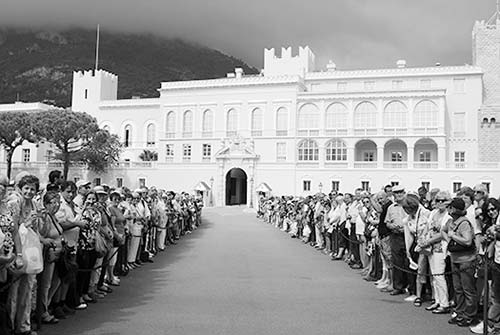
Cost and Hours: €8, includes audioguide, €20.50 combo-ticket includes Oceanography Museum; hours vary but generally daily 10:00-18:00, July-Aug until 19:00, closed Nov-March; buy ticket at the Billeterie at the souvenir stand 75 yards opposite the palace entrance; tel. 00-377/93 25 18 31, www.palais.mc.
• Head to the west end of the palace square. Below the cannonballs is the district known as...
Monaco’s newest, reclaimed-from-the-sea area has seen much of Monaco’s post-WWII growth (residential and commercial—notice the lushly planted building tops). Prince Rainier continued—some say, was obsessed with—Monaco’s economic growth, creating landfills (topped with apartments, such as in Fontvieille), flashy ports, more beaches, a big sports stadium marked by tall arches, and a rail station. (An ambitious new landfill project is in the works and would add still more prime real estate to Monaco’s portfolio.) Today, thanks to Prince Rainier’s past efforts, tiny Monaco is a member of the United Nations. (If you have kids with you, check out the nifty play area just below.)
• With your back to the palace, leave the square through the arch at the far right (onto Rue Colonel Bellando de Castro) and find the...
The somber but beautifully lit cathedral, rebuilt in 1878, shows that Monaco cared for more than just its new casino. It’s where centuries of Grimaldis are buried, and where Princess Grace and Prince Rainier were married. Inside, circle slowly behind the altar (counterclockwise). The second tomb is that of Albert I, who did much to put Monaco on the world stage. The second-to-last tomb—inscribed “Gratia Patricia, MCMLXXXII” and displaying the 1956 wedding photo of Princess Grace and Prince Rainier—is where the princess was buried in 1982. Prince Rainier’s tomb lies next to hers (cathedral open daily 8:30-19:15).
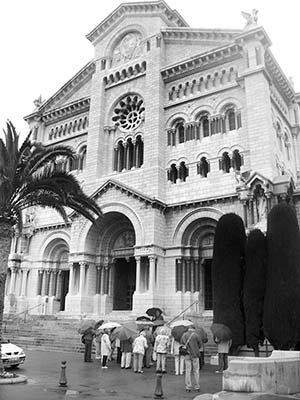
• Leave the cathedral and dip into the immaculately maintained Jardin Botanique, with more fine views. In the gardens, turn left. Eventually you’ll find the impressive building housing the...
Prince Albert I had this cliff-hanging museum built in 1910 as a monument to his enthusiasm for things from the sea. The museum’s aquarium, which Jacques Cousteau captained for 32 years, has 2,000 different specimens, representing 250 species. You’ll find Mediterranean fish and colorful tropical species (all well described in English). Rotating exhibits occupy the entry floor. Upstairs, the fancy Albert I Hall is filled with ship models, whale skeletons, oceanographic instruments and tools, and scenes of Albert and his beachcombers hard at work—but sadly, only scant English information. Don’t miss the elevator to the rooftop terrace view café.
Cost and Hours: €11-16, kids-€7-12 (price depends on season), €20.50 combo-ticket includes Prince’s Palace; daily 10:00-19:00, longer hours July-Aug, Oct-March until 18:00; down the steps from Monaco-Ville bus stop, at the opposite end of Monaco-Ville from the palace; tel. 00-377/93 15 36 00, www.oceano.mc.
• The red-brick steps across from the Oceanography Museum lead up to stops for buses #1 and #2, both of which run to the port, the casino, and the train station. To walk back to the palace and through the old city, turn left at the top of the brick steps. If you’re into stamps, walk down Rue Emile de Loth to find the post office, where philatelists and postcard writers with panache can buy—or just gaze in awe at—the impressive collection of Monegasque stamps.
This cliffside municipal garden, located above Monaco-Ville, has eye-popping views from France to Italy. It’s home to more than a thousand species of cacti (some giant) and other succulent plants, but worth the entry only for view-loving botanists (some posted English explanations provided). Your ticket includes entry to a skippable natural cave, an anthropological museum, and a view snack bar/café. You can get similar views over Monaco for free from behind the souvenir stand at the Jardin’s bus stop; or, for even grander vistas, cross the street and hike toward La Turbie.
Cost and Hours: €7.20, daily 9:00-19:00, Oct-April until about dusk, take bus #2 from any stop in Monaco or take the elevator up from the Nice end of the train station and follow signs, tel. 00-377/93 15 29 80, www.jardin-exotique.com.
Monte Carlo, which means “Charles’ Hill” in Spanish, is named for the prince who presided over Monaco’s 19th-century makeover. In the mid-1800s, olive groves stood here. Then, with the construction of casino and spas, and easy road and train access (thanks to France), one of Europe’s poorest countries was on the Grand Tour map—the place for the vacationing aristocracy to play. Today, Monaco has the world’s highest per-capita income.
Count the counts and Rolls-Royces in front of the casino and Hôtel de Paris. The hotel was built at the same time as the casino to house gamblers—transportation back to Nice was not as fast as it is today (visitors allowed in the hotel, no shorts). The odd bubble-like structures that line the parkway above the casino are temporary, and house high-end boutiques relocated from nearby for a long-term construction project. Ignore the tacky American-style casino that hides behind the outdoor café across from the hotel.
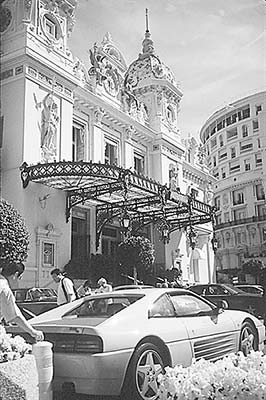
The Monte Carlo casino is intended to make you feel comfortable while losing your retirement nest egg. Charles Garnier designed the place (with an opera house inside) in 1878, in part to thank the prince for his financial help in completing Paris’ Opéra Garnier (which the architect also designed). The central doors provide access to slot machines, gaming rooms, and the opera house. The gaming rooms occupy the left wing of the building. Cruise ship visitors can jam the entry during afternoons.
Cost and Hours: Tightwads can view the atrium entry, classy bar/café, and slot-machine room for free; daily 9:00-late. Touring the casino costs €17 (€12 off-season); daily 9:00-12:15; you’ll see the atrium area and inner-sanctum gaming rooms with an audioguide, take photos, and have your run of the joint. Gamblers pay €10; daily 14:00 until the wee hours, must be 18 and show ID; no shorts, T-shirts, hoodies, tennis shoes, or torn jeans. Whether you gamble or not, expect lines at the entrance from May through September; tel. 00-377/92 16 20 00, www.montecarlocasinos.com.
Visiting the Casino: Enter through sumptuous atrium. This is the lobby for the 520-seat opera house (open Nov-April only for performances). A model of the opera house is at the far-right side of the room, near the bar-café. The first gambling rooms (Salle Renaissance, Salon de l’Europe, and Salle des Amériques) offer European and English roulette, plus Trente et Quarante, Punto Banco—a version of baccarat—and slot machines. The more glamorous game rooms (Salons Touzet, Salle Medecin, and Terrasse Salle Blanche) have those same games and Ultimate Texas Hold ’em poker, but you play against the cashier with higher stakes.
The scene, flooded with camera-toting tourists during the day, is great at night—and downright James Bond-like in the private rooms. This is your chance to rub elbows with some high rollers. The park behind the casino is a peaceful place with a good view of the building’s rear facade and of Monaco-Ville.
Eating: The casino has two dining options. The $$$$ Train Bleu restaurant is for deep pockets for whom price is no object and elegance is everything. $$$ Le Salon Rose offers brasserie food—big salads and pasta dishes in a classy setting. If you paid to tour the casino or to gamble, show your ticket for a discount.
Take the Money and Run: The stop for buses returning to Nice and Villefranche-sur-Mer, and for local buses #1 and #2, is on Avenue de la Costa, at the top of the park above the casino (at the small shopping mall; for location, see the “Monaco” map). To reach the train station from the casino, take bus #1 or #2 from this stop, or find Boulevard Princesse Charlotte (parallels Avenue de la Costa one block above) and walk 15 minutes.
(See “Monaco” map.)
Sleeping: Centrally located in Monaco-Ville, $$ Hôtel de France** is comfortable, well run by friendly Sylvie and Christoph, and reasonably priced—for Monaco (includes breakfast, air-con, no elevator; exit west from train station, 10-minute walk to 6 Rue de la Turbie, tel. 00-377/93 30 24 64, www.hoteldefrance.mc, hoteldefrance@monaco.mc).
Eating on the Port: Several cafés serve basic, inexpensive fare (day and night) on the port. Troll the places that line the flowery and traffic-free Rue Princesse Caroline between Rue Grimaldi and the port. $$$ Huit et Demi is a reliable choice, with a white-tablecloth-meets-director’s-chair ambience and good outdoor seating (closed Sun, 7 Rue Princesse Caroline, tel. 00-377/93 50 97 02). A few blocks below, $$ Bella Vita—an easygoing place for salads, Italian fare, and classic French dishes—has a large terrace and modern interior (daily, serves nonstop from morning to late, 21 Rue Princesse Caroline, tel. 00-377/93 50 42 02).
Eating in Monaco-Ville: You’ll find sandwiches—including the massive pan bagnat, basically salade niçoise on country bread—and quiche at the yellow-bannered $ Boulangerie (daily until 19:00, near Place du Palais at 8 Rue Basse). At $$ U Cavagnetu, just a block from Albert’s palace, you’ll dine cheaply on specialties from Monaco—pizza and such (daily, serves nonstop 11:00-23:00, 14 Rue Comte Félix Gastaldi, tel. 00-377/97 98 20 40). Monaco-Ville has other pizzerias, crêperies, and sandwich stands, but the neighborhood is dead at night.
For a comparison of train and bus connections, see the “Public Transportation in the French Riviera” sidebar on here. Most trains heading west will stop in Villefranche-sur-Mer, Nice, and Antibes (ask). The last train leaves Monaco for Villefranche-sur-Mer and Nice at about 23:30.
From Monaco by Train to: Villefranche-sur-Mer, Nice, Antibes, or Cannes (2/hour).
Frequent bus #100, which runs along the Low Corniche back to Nice (1 hour), and Villefranche-sur–Mer (40 minutes) is often slammed. For a better chance of securing a seat, board at the stop near the TI on Avenue de la Costa (see the “Monaco” map earlier in this chapter) rather than the stop near Place d’Armes. The last bus leaves Monaco for Nice at about 21:30. In the other direction bus #100 goes to Menton (30 minutes). For bus details, including tickets, routes, frequencies, and travel times, see the “Getting Around the Riviera” section in the French Riviera chapter.
Bus #112, which goes along the scenic Middle Corniche to Eze-le-Village then on to Nice (6/day Mon-Sat, none on Sun, 20 minutes to Eze), departs Monaco from Place de la Crémaillère, one block above the main TI and casino park. Walk up Rue Iris with Barclays Bank to your left, curve right, and find the bus shelter across the street at the green La Crémaillère café.
Bus #11 to La Turbie (9/day Mon-Sat, 5/day Sun, 30 minutes) stops in front of the TI (same side of street).
Bus #110 express takes the freeway from the Place d’Armes stop to Nice Airport (2/hour, 50 minutes, €22).
Cruise ships tender passengers to the end of Monaco’s yacht harbor, a short walk from downtown. It’s a long walk or a short bus ride to most sights in town. To reach other towns, such as Villefranche-sur-Mer or Nice, you can take public transportation. To summon a taxi (assuming none are waiting when you disembark), look for the gray taxi call box near the tender dock—just press the button and wait for your cab to arrive.
Getting into Town: To reach Monaco-Ville, which towers high over the cruise terminal, you can either hike steeply and scenically up to the top of the hill, or walk to Place d’Armes and hop on bus #1 or #2, which will take you up sweat-free. It’s a 15-minute, level walk to the bus stop from the port: Cross Boulevard Albert I, follow green Gare S.N.C.F./Ferroviare signs, and take the public elevator to Place d’Armes.
The ritzy skyscraper zone of Monte Carlo is across the harbor from the tender dock, about a 25-minute walk. You can also ride the little electric “bateau bus” shuttle boat across the mouth of the harbor (works with a bus ticket). To reach the upper part of Monte Carlo—with the TI and handy bus stops (including for Eze-le-Village and La Turbie)—catch bus #1 or #2 at the top of the yacht harbor, along Boulevard Albert I.
Getting to Sights Beyond Monaco: Monaco is connected to most nearby sights by both train and bus. See the “Arrival in Monaco” section early in this chapter as well as the bus and train connection information in this section for details.
The train station is about a 20-minute walk from the tender harbor—first walk to Place d’Armes (directions above under “Getting into Town”), then follow Rue Grimaldi to find stairs and an elevator to the station. For buses, see earlier for bus stop locations and frequencies. If taking bus #112 to Eze-le-Village or bus #11 to La Turbie, first ride bus #1 or #2 to the TI and casino, then follow the directions above.
If you wish the Riviera were less glitzy and more like a place where locals take their families to lick ice cream and make sand castles, visit Menton (east of Monaco). Menton feels like a poor man’s Nice. It’s unrefined and unpretentious, with lower prices, fewer rentable umbrellas, and lots of Italians day-tripping in from right over the border (five miles away). There’s not an American in sight.
Getting There: While trains serve Menton regularly (35 minutes from Nice, 10 minutes from Monaco), the station is a 15-minute walk from the action. Buses are much slower (1.5 hours from Nice, 30 minutes from Monaco) but they drop visitors right on the beach promenade (bus #100; see the “Getting Around the Riviera” section in the French Riviera chapter for details). If coming from a day trip via Monaco, take the bus here and train back to your home base.
Visiting Menton: Menton’s TI is at 8 Avenue Boyer (tel. 04 92 41 76 76, www.tourisme-menton.fr). Though a bit rough, the Menton waterfront is a joy. An inviting promenade lines the beach, and seaside cafés serve light meals and salads at good prices. A snooze or stroll here is a fine Riviera experience. From the promenade, a pedestrian street leads through town. Small squares are alive with jazz bands playing crowd-pleasers under palm trees.
Stepping into the old town—which blankets a hill capped by a fascinating cemetery—you’re immersed in a pastel-painted, yet dark-and-tangled Old World scene with (strangely) almost no commerce. A few elegant restaurants dig in at the base of the towering centuries-old apartment flats. The richly decorated Baroque St. Michael’s Church (midway up the hill, Mon-Fri 10:00-12:00 & 15:00-17:15, closed to visitors Sat-Sun) is a reminder that, until 1860, Menton was a thriving part of the larger state of Monaco. Climbing past sun-grabbing flower boxes and people who don’t get out much anymore, the steep stepped lanes finally deposit you at the ornate gate of a grand cemetery that fills the old castle walls. Explore the cemetery, which is the final resting place of many aristocratic Russians (buried here in the early 1900s) and offers breathtaking Mediterranean views.